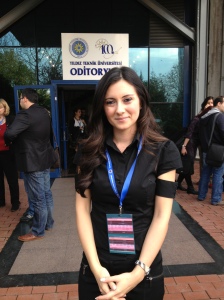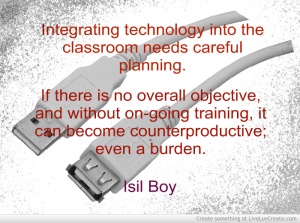 The interview with Işıl Boy, the Teacher Trainer at Pilgrims, ICT Coordinator
The interview with Işıl Boy, the Teacher Trainer at Pilgrims, ICT Coordinator @YTU, MA EdTech & TESOL St. (University of Manchester), IATET representative for Turkey, iTDi Associate and organiser of the 1st International Wired In or Out Symposium
1. How did the idea of an International Symposium come to you?
Contrary to what most people think, this symposium on web technologies was not my idea. Our Vice-Director, Ayşegül Kıvanç, came up with this idea and was willing to organize something different. First, we thought it could be a one-day symposium. However, since there were many speakers I wanted to invite, we ended up organizing a two-day event. At the same time, we had no budget. So, I couldn’t invite them at all. Hence, I would like to extend my heartfelt thanks and gratitude to all the speakers and sponsors who made this event happen.
2. What does the conference name “Wired In or Out” mean?
It came from my dear colleague, Filiz Diskaya; she was inspired by the movie “Facebook” and we all loved the idea.
3. In what cases can the use of technology, such as various ICT tools, be counterproductive and, perhaps, time consuming?
Integrating technology into the classroom needs careful planning. If there is no overall objective, and without on-going training, it can become counterproductive; even a burden. It is not enough to know how to use a web tool or an app; in fact, that is the easiest part. We need to consider whether our objective is technology-centered (the focus is on the capabilities of cutting edge technology) or learner-centered (the focus is on the way that people learn and process information).
So, the web tools we are planning to use need to be in line with the objectives. Then, we should make sure that every student knows how to use that tool. We cannot simply assume that every student in our classroom is tech-savvy. We also need to share our objectives with our students, and set some rules. Otherwise, students will think that they are just playing games on the computer. Indeed, we should help our students to see computers, or tablets, as educational tools rather than toys or machines for playing games .
Some institutions tend to believe that it is enough to install hardware in the classroom and ‘dip’ teachers into brief training workshops, but it doesn’t work. (Hoffman, 1996) Here, there comes a need for the investigation of Technological Pedagogical Content Knowledge (TPACK) which intends to determine the nature of information demanded by teachers who are integrating technology into their teaching. TPACK framework has three main focus: content, pedagogy and technology; it suggest blending technology knowledge with pedagogy and content knowledge in order to achieve effective technology integration. (Mathew Koehler and Punya Mishra, 2006).
4. Can you please give an example of a successful use of technology in your classroom?
I have been using pbworks wikis for three years now and I have experienced several benefits. The main reasons why I chose to explore wikis are because they encourage transparent learning, promote learner autonomy, develop digital literacy, stimulate collaborative learning and foster motivation. Wikis are also one of the most popular asynchronous tools for writing practice. Smith, Alvarez-Torres & Zhao (2003:706) hold the view that asynchronous communication gives more time to work on a reply; hence promotes more in-depth understanding of the
information along with more thoughtful responses. Wikis also serve an important role to develop educational courseware; hence teachers will also be able to develop their courseware to collect their web-based and mobile learning materials. I have also developed courseware on wikis:http://blogging.humanities.manchester.ac.uk/mewxjib4. My objectives in designing this courseware were to show teachers how to use wikis in depth, to introduce some examples on wikis for classroom use, to show them some tools and apps which they can use on wikis, to help them test themselves on what and how much they have learned, and to encourage them to start using wikis. My foremost aim, while designing and developing this courseware, was to make it engaging so that teacher would be willing to use wikis with their students.
5. What’s your favorite application at the moment? Why?
I must say that I am an avid iPad user and my favorite application is Zite which is a free personalized magazine that automatically learns what you like and gets smarter every time you use it.
6. Isil, the First International Symposium has been a major success. What is next on your to-do list?
My course on “Using Mobile Technology” and my dissertation on mobile learning, and the use of iPads in teaching. I am pretty excited about my new mLearning course, and I am going to run it both at Pilgrims in Canterbury, in Istanbul and in Izmir. I have already explored teachers’ beliefs about the use of iPads in teaching for my MA assignment, and I am going to focus on the same topic for my dissertation. I am also planning to organize another conference but this time it will be totally different.
Symposium blog:http://yildizunieltsymposium12.wordpress.com (A special thanks to our roving reporter, Vicky Loras, and our British Council interviewer, Rakesh Bhanot).
Symposium hashtag: #ytuelt
REFERENCE
Mishra, P., & Koehler, M. J. (2006). Technological pedagogical content knowledge:
A framework for integrating technology in teachers’ knowledge. Teachers College Record, 108(6), 1017–1054.
Smith, B., Alvarez-Torres, M. J. & Zhao, Y. (2003). Features of CMC technologies and their impact on language learners’ online interaction. Computers in Human Behavior. 19(6), 703-729
Hoffman, B. (1996): What Drives Successful Technology Planning, Journal ofInformation Technology for Teacher Education.
